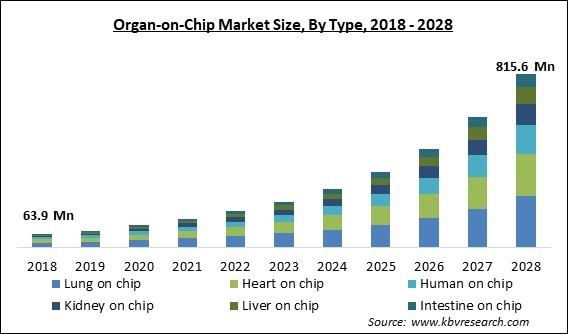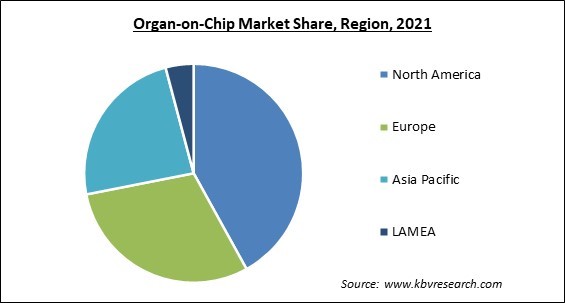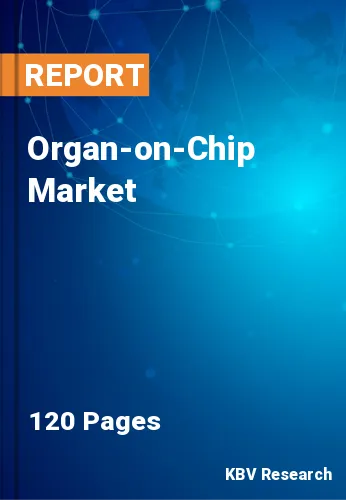The Global Organ-on-Chip Market size is expected to reach $815.6 million by 2028, rising at a market growth of 30.2% CAGR during the forecast period.
Organs-on-chips are microfluidic chips that contain artificial or natural tiny tissues. To better imitate human physiology, the chips are manufactured to retain tissue-specific cell microenvironments and functionalities. Combining advancements in microfabrication and tissue engineering, OoCs have received interest as a next-generation experimental platform for investigating human pathology and its therapeutic effects on the body. There are as many instances of OoCs as there are implementations, making it challenging for new researchers to comprehend what makes one OoC more suitable than another for a particular application.

Organ-on-a-chip is an artificial organ that mimics human organs. It is a multi-channel, three-dimensional microfluidic cell culture technology that promotes organ functions, processes, and physiological responses. The combination of labs-on-chips and cell biology has enabled researchers to analyze human physiology within an organ-specific environment, leading to the creation of a new model of multicellular human organisms in vitro.
This chip creates a small channel for air and blood flow in organs, such as the lung, digestive tract, liver, brain, and heart. These devices are constructed on a microchip with constantly perfused compartments colonized with living cells designed to stimulate tissue and organ-level physiology. Organ-on-chip is a silicon-based technology that is used to nourish interior organs.
Combining tissue engineering and microfluidics, organ-on-a-chip is a potentially revolutionary technique. It is anticipated that these technologies would provide effective solutions to long-standing problems in drug discovery and tailored illness therapy. It plays a significant part in medication development research, hence bolstering the organ-on-chip sector.
The COVID-19 pandemic significantly impacted a number of economies all over the world. various businesses were majorly demolished owing to the widespread infection. Governments in several countries were compelled to impose lockdowns within their countries in order to regulate the diffusion of the virus. Due to this, the manufacturing of numerous products was hampered. In addition, the Healthcare sector was also impacted severely during the initial period of the pandemic. The abrupt emergence of the pandemic. The organ-on-chip market was also disrupted by the pandemic. There was a lack of equipment required to leverage the potential of this approach, which impeded the growth of the market in the initial period of the pandemic.
TMicrofluidic devices and organotypic slices have been combined to improve culture survival. The conventional method for cultivating organotypic brain slices (about 300 microns in thickness) uses semi-porous membranes to form an air-medium interface. Because microfluidic technologies bring the laminar flow of these essential nutrients and gases, tissue viability can be increased and transportation is enhanced. Brain-on-a-chip technologies have enabled the effective culture of thicker brain slices despite a substantial transport barrier due to their thickness. Brain-on-a-chip systems can attain more in vivo-like qualities without sacrificing cell viability, as thicker slices preserve more native tissue architecture.
Animal models were the only means to gather in vivo data that could predict human pharmacokinetic reactions during the early stages of drug development. However, animal experiments are slow, costly, and controversial. For instance, animal models are frequently subjected to chemical or mechanical procedures that replicate human injuries. Concerns exist regarding the validity of such animal models due to a lack of extrapolation between species.
In drug discovery and development, OOCs are regarded as more relevant and precise than experimental animals or cell cultures. However, the cost of these chips and the redesigning processes necessary for scale production are substantial. High costs of production are impeding the expansion of the OOC market, as the relatively small enterprises involved may be unable to afford the redesigning process.

By Type, the Organ-On-Chip Market is segregated into Heart on chip, Human on chip, Intestine on chip, Kidney on chip, Liver on chip, and Lung on chip. In 2021, the lung-on-chip segment acquired the largest revenue share of the organ-on-chip market. Attempts are being made to increase the physiological applicability of current in vitro alveolar-capillary interface models by developing lung-on-chips. Such a multifunctional microdevice can duplicate important structural, functional, and mechanical aspects of the alveolar-capillary interface in humans.
| Report Attribute | Details |
|---|---|
| Market size value in 2021 | USD 134 Million |
| Market size forecast in 2028 | USD 815.6 Million |
| Base Year | 2021 |
| Historical Period | 2018 to 2020 |
| Forecast Period | 2022 to 2028 |
| Revenue Growth Rate | CAGR of 30.2% from 2022 to 2028 |
| Number of Pages | 120 |
| Number of Tables | 200 |
| Report coverage | Market Trends, Revenue Estimation and Forecast, Segmentation Analysis, Regional and Country Breakdown, Companies Strategic Developments, Company Profiling |
| Segments covered | Type, Region |
| Country scope | US, Canada, Mexico, Germany, UK, France, Russia, Spain, Italy, China, Japan, India, South Korea, Singapore, Malaysia, Brazil, Argentina, UAE, Saudi Arabia, South Africa, Nigeria |
| Growth Drivers |
|
| Restraints |
|
Region-Wise, the Organ-On-Chip Market is analyzed across North America, Europe, Asia-Pacific, and LAMEA. In 2021, North America procured the biggest revenue share of the organ-on-chip market. This is due to the increasing prevalence of technologically superior models, the existence of key players, and the increase in drug research and development R&D efforts in regional countries. Furthermore, North American countries are early adopters of a number of novel technologies and approaches.
Free Valuable Insights: Global Organ-on-Chip Market size to reach USD 815.6 Million by 2028
The market research report covers the analysis of key stake holders of the market. Key companies profiled in the report include AxoSim, Inc., Visikol, Inc., CN Bio Innovations Limited., Elveflow (Elvesys Group), Emulate, Inc., Insphero AG, Mimetas B.V., Nortis Inc., Organovo Holdings, Inc. and TARA Biosystems, Inc.
By Type
By Geography
The global Organ-on-Chip Market size is expected to reach $815.6 million by 2028.
Rapidly Rising Number of Applications of This Approach are driving the market in coming years, however, High Cost Associated with The Deployment of OOCs restraints the growth of the market.
AxoSim, Inc., Visikol, Inc., CN Bio Innovations Limited., Elveflow (Elvesys Group), Emulate, Inc., Insphero AG, Mimetas B.V., Nortis Inc., Organovo Holdings, Inc. and TARA Biosystems, Inc.
The expected CAGR of the Organ-on-Chip Market is 30.2% from 2022 to 2028.
The North America market dominated the Global Lung on chip Market by Region in 2021; thereby, achieving a market value of $94.9 Million by 2028.
Our team of dedicated experts can provide you with attractive expansion opportunities for your business.

